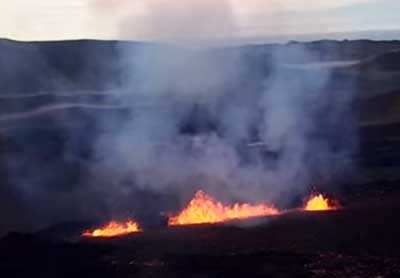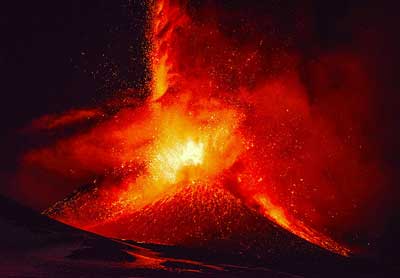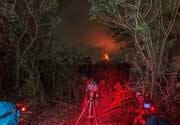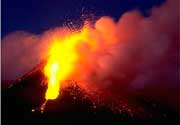Waiting for eruption number 7
Update Fri 26 Feb 2021 10:11
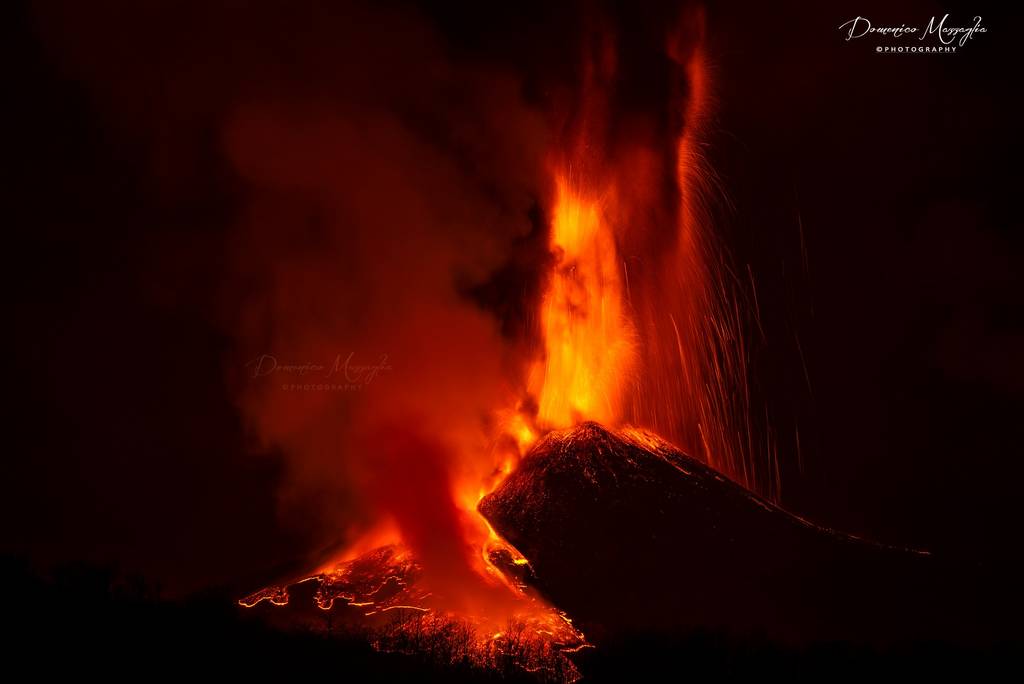
Lava fountain during Etna's paroxysm during 24-25 Feb night (image: Domenico Mazzaglia / facebook)
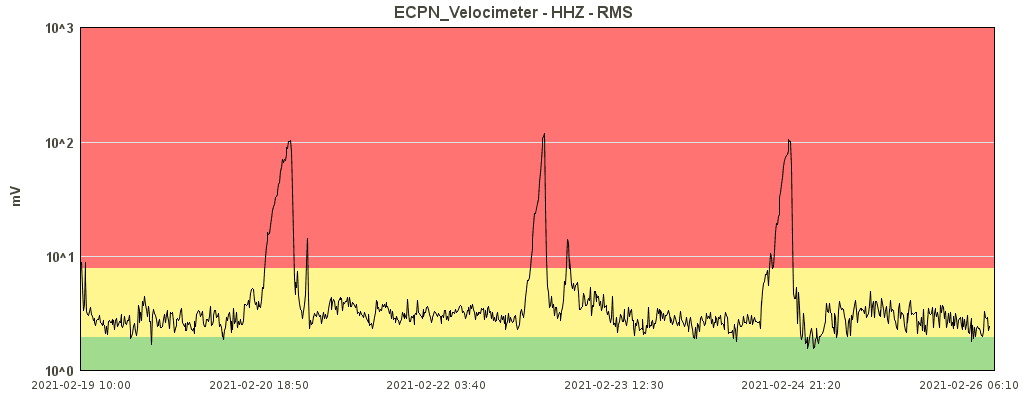
Current tremor signal (image: INGV Catania)
If the amazingly regular current activity continues, a new lava fountaining episode known as paroxysm is likely to occur, and expected by many, during the following night.
Be sure to watch the various
Etna webcams or various contributors, almost in real time, on our
Facebook groupClockwork Etna - 6th paroxysm in a row in little more than 7 days
Wed, 24 Feb 2021, 20:41 20:41 PM | BY: T

Lava fountain from Etna's New SE crater seen from the INGV webcam on Montagnola

Thermal image of the lava fountains showing their size (image: thermal webcam of INGV on Montagnola)
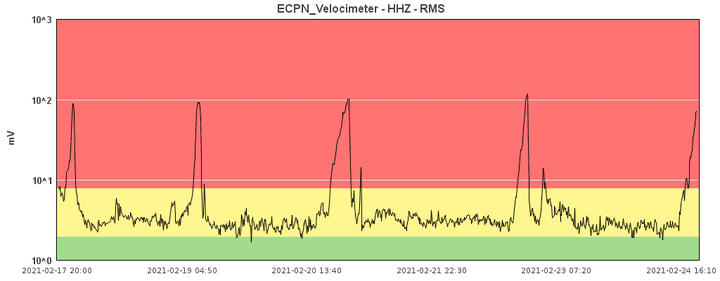
Currentr tremor signal (image: INGV Catania)
The amazing show at Europe's most active volcano goes on!
Following the amazingly regular pattern of paroxysms (fire-fountaining episodes) at almost identical intervals of around 35-48 hours, the 6th eruption in a row is now in full swing!
It seems to follow exactly the patterns observed during the previous events. Accompanied by increasing volcanic tremor, explosive activity from the New SE crater began to rise slowly this evening, and has now developed into tall, sustained lava fountains now reaching 500-700 m of meters in height, but still increasing!
Lava flows are traveling from the SE crater to the SW and East into the Valle del Bove, overlapping the previous ones.
Watch it live:
Waiting for a new eruption
Update Wed 24 Feb 2021 09:15

Mild strombolian activity early this morning at Etna's New SE crater

Current tremor signal - when will the next peak appear? (image: INGV Catania)
After the extremely powerful paroxysm (lava fountaining episode) during the night 22-23 Feb, which came as the 5th in a row following very regular intervals many people around the world are probably wondering whether the volcano will continue this remarkable series of eruptions.
If the last interval is an indicator as to when to expect a new paroxysm, it might well be in the course of the next night - something volcanologists, but also thousands of nearby residents, volcano spotters, and many more people from all over the world via
webcams are certain to follow closely.
Since the end of the most recent activity, Etna has returned to intermittent mild summit activity from at least 4 of its summit vents, and volcanic
tremor levels, kindly provided in real time by the National Institute of Volcanology and Geophysics (INGV) in Catania, are currently low. When this changes, be prepared for another show of fire! What we don't know from the publicly available data is whether the volcano currently inflates, which would be an indication that the volcano is about to recharge itself. This leaves us with the fun to speculate!
Etna erupts lava fountains over 1000 m high
Update Tue 23 Feb 2021 07:41
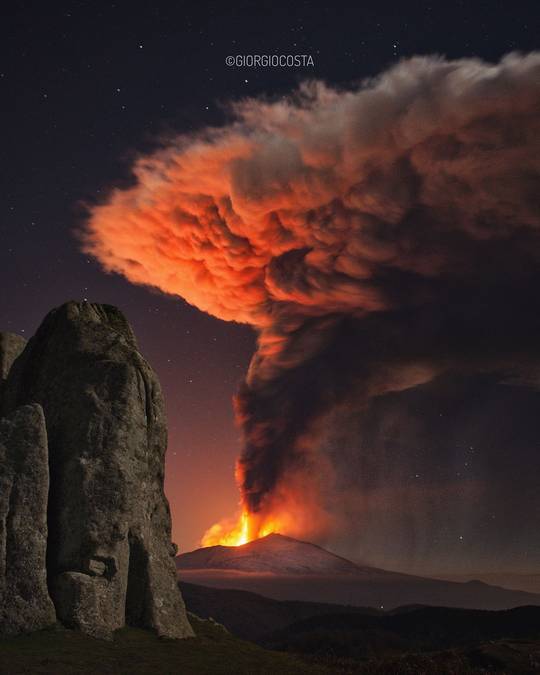
Tall lava fountains more than 1000 m high and spectacular eruption column from last night's paroxysm on Etna (image: Giorgio Costa / facebook)
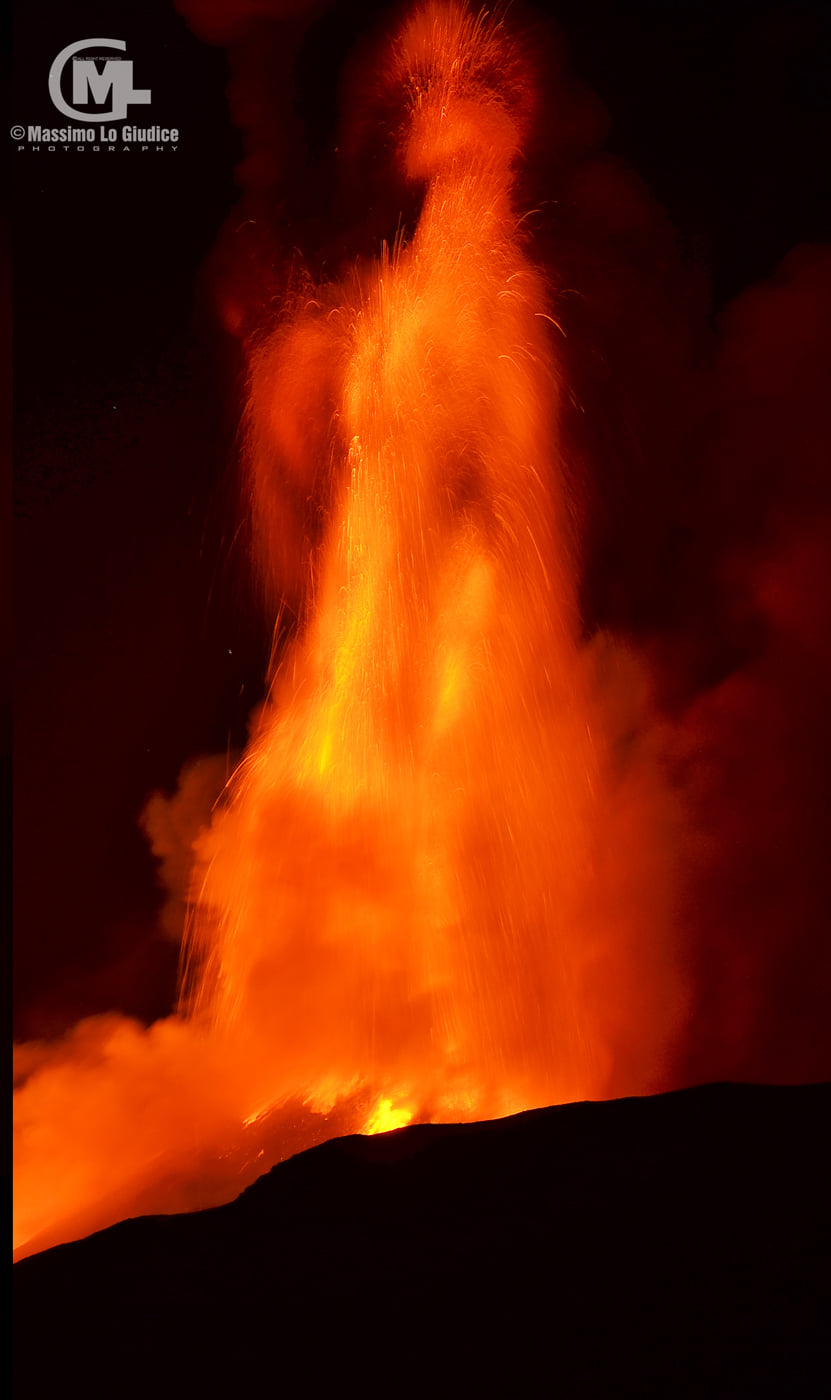
Lava fountain during the eruption (image: Massimo Lo Giudice / facebook)

The eruption seen from Linguaglosso on the NE (image: Massimo Lo Giudice / facebook)

Thermal image from Nicolosi showing the impressive height of the fountains (image: INGV Catania)
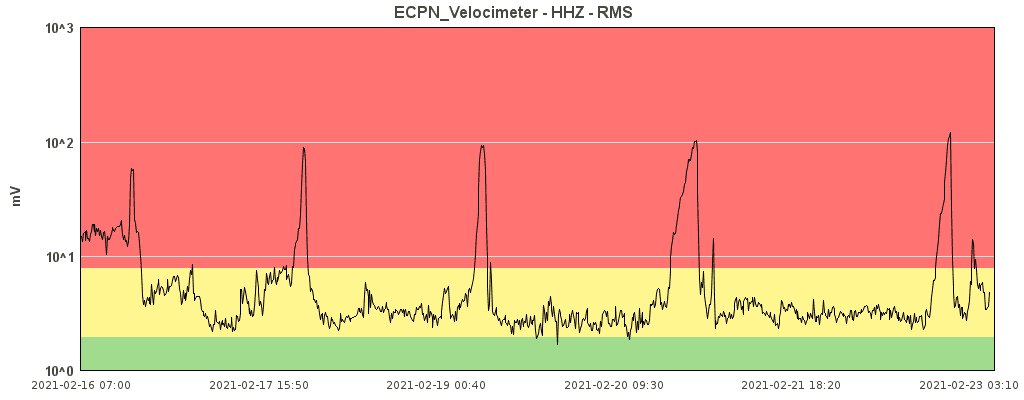
Current tremor signal (image: INGV Catania)
Once more, Etna produced a very impressive show of unsurpassed fireworks at night: The - awaited - 5th lava fountaining episode (known as paroxysm) occurred late at night and turned out to be particular violent, equal or even stronger than the previous one 48 hours earlier. It was the 5th in a row during a single week's time!
The events building up to the eruption were quite typical and similar to the previous paroxysms: at first, the until-then intermittent and mild strombolian activity from the New SE crater gradually picked up, starting from around 10 pm local time. At the same time, volcanic tremor started to show a steep increase, sign of magma moving upwards inside the volcano's conduits.
The activity began to turn into sustained lava fountains from around midnight, and continued to increase in intensity. Around 00:30, the activity reached its peak phase with very tall lava fountains surpassing 1000 m height! An impressive eruption column of ash and steam rose to probably more than 10 km altitude and spread into an impressive, near-circular umbrella cloud towering over eastern Sicily.
At around 1:05 am, activity quickly ceased, with a phase of reactivation during approx. 4.40 and 6 am, when a series of strong explosions occurred at the SE crater complex.
Similarly to the previous events, lava flows were erupted to the SW and the east of the New SE crater into Valle del Bove, reaching similar lengths as before.
Image sources:
-
Giorgio Costa (facebook)
-
Massimo Lo Giudice (facebook)
New lava fountaining eruption underway, 5th in a row now
Update Mon 22 Feb 2021 21:42
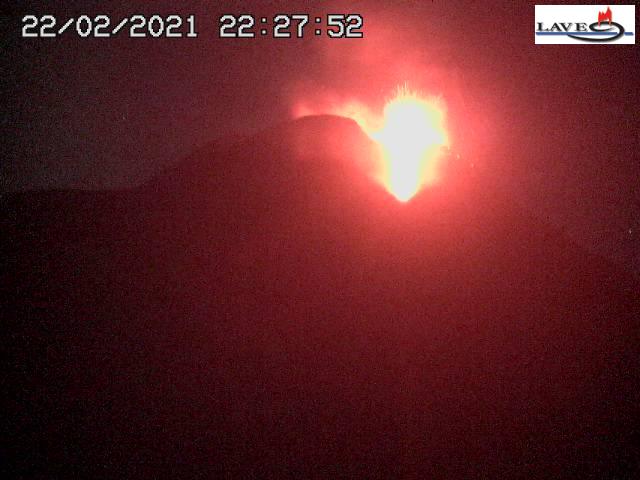
Intense strombolian activity at the eastern vent of the New SE crater
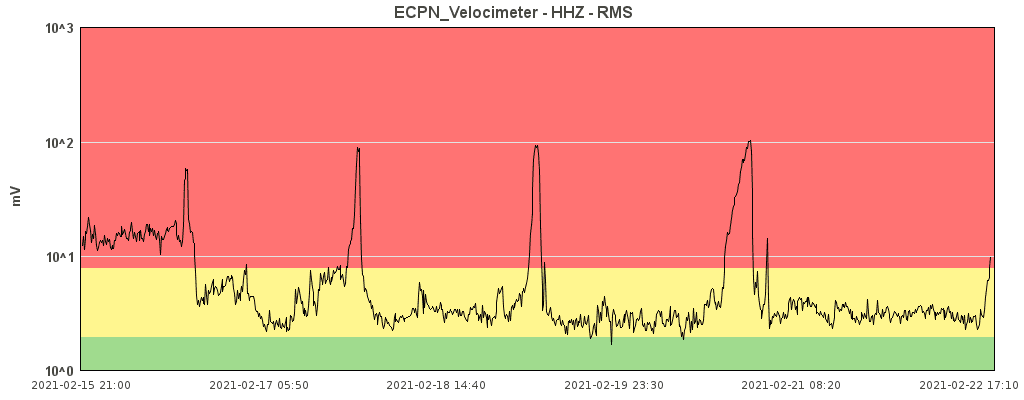
Current tremor signal (image: INGV Catania)
Yet another phase of lava fountaining, or paroxysms, is almost certainly about to start now. Volcanic tremor has started to rise sharply from low to now already high levels, and strombolian activity at the eastern vent of the New SE crater is becoming more and more intense and near-continuous.
The 5th paroxysm in a row and within a single week comes after a slightly longer interval, approx. 48 hours, than the very regular roughly 35 hours intervals between each of the previous four events.
Given that the last one was very intense compared to the first three, it might not be surprising. Maybe the time to recharge or reproduce the right conditions deeper below for a new gas-rich batch of fresh magma to start rising just took a bit longer.
When will be the next eruption?
Update Mon 22 Feb 2021 08:16
Once more, about 35 hours have now passed since the latest lava fountaining episode (paroxysm) at the volcano. If the pattern visible as the volcanic tremor spikes continues, a new one could be expected to start in the coming hours...
Powerful lava fountains rise up to 1000 m at Europe's most active volcano
Update Sun 21 Feb 2021 17:08

View of the eruption at night with its impressive umbrella cloud (image: Massiimo Lo Giudice / facebook)
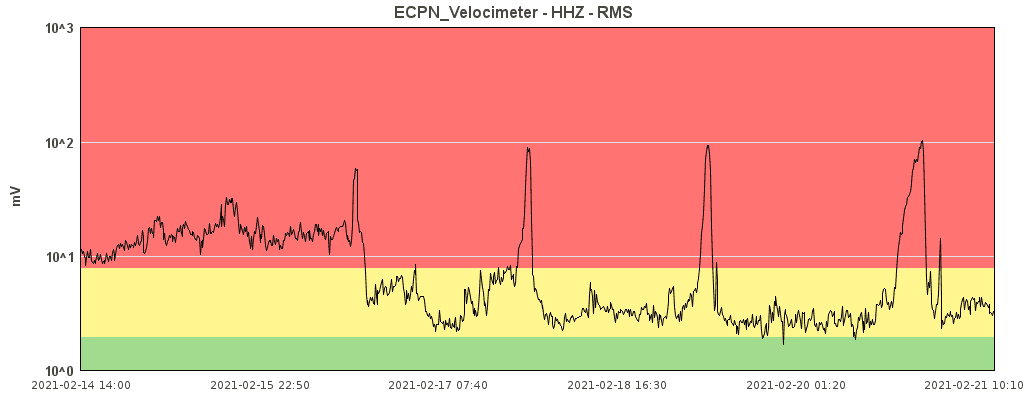
Current tremor signal (image: INGV Catania)
Last night's eruptive episode of tall lava fountains, known as paroxysm, turned out to be one of the most impressive and powerful in recent years. Not only did it produce higher fire fountains than usually, but also it lasted longer than most other paroxysms.
Around 10:30 p.m. local time, volcanic tremor and strombolian activity from the New SE crater began to increase drastically. Half an hour later, a first lava flow started to descend from the eastern summit vent of the crater, and activity continued to increase, soon forming fountains of a few hundred meters tall.
However, instead of peaking (and decreasing) very soon, activity continued to increase and first reached its climax at around 00:30 this morning, with fire fountains reaching the incredible heights of 800-1000 m! Thanks to the near-absence of wind, a tall eruption column of over 10 km height formed with a circular umbrella cloud at the boundary between troposphere and stratosphere (see attached image by
Massimo Lo Giudice on facebook)
The eruption ended abruptly at 2 a.m., thus having produced sustained lava fountains for almost 3 hours!
Time-lapse video of the eruption:
The National Institute of Geophysics and Volcanology (INGV Catania) reported that during the eruption, at least 3 vents of the New SE crater were active. The first lava flow from the so-called saddle vent descended to the southwest towards the Torre del Filosofo area, but eventually only reached a few hundred meters length. Most lava was directed into a more voluminous flow traveling east into the Valle del Bove, where it reached a length of 3.5-4 km and stopped in similar areas as the ones from the previous paroxysms, at elevations between 1700-1800 m.
The eruptive activity had dropped already, but the New SE crater reactivated itself in a series of approx. 20 very violent explosions between 04:30-05:15 local time, which launched incandescent bombs beyond the base of the cone.
After 05:15, no more eruptive activity was observed at the New SE crater, while mild strombolian activity is continuing from the other summit vents (Bocca Nuova, Voragine).
It will be interesting to see whether Etna continues its current rhythmic pattern of paroxysms every roughly 35 hours. If so, the 5th of the current series should occur around noon tomorrow...
4th lava fountaining eruption within 5 days comes at remarkable same interval since previous
Update Sat 20 Feb 2021 22:57
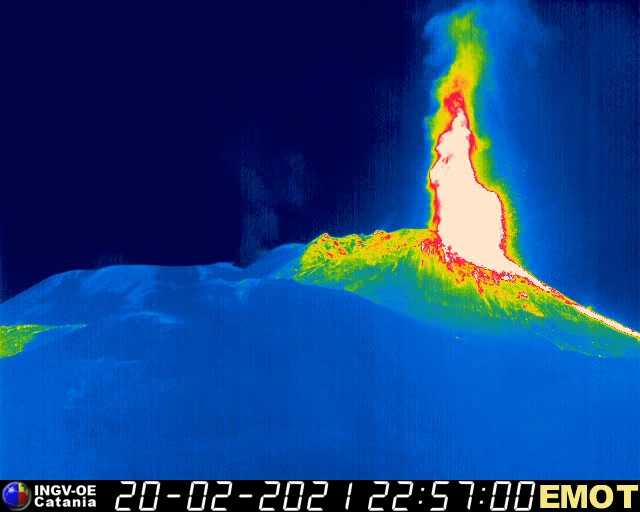
Lava fountain from Etna's New SE crater during the paroxysm on 20-21 Feb 2021 (image: thermal webcam INGV Catania)
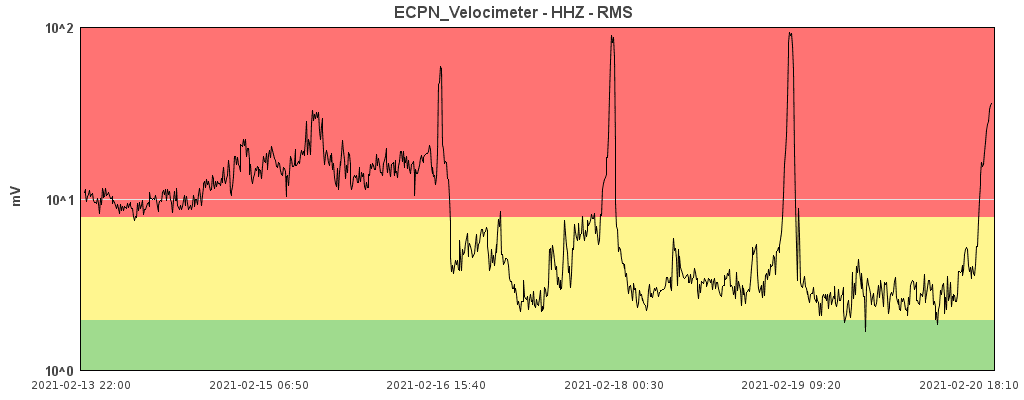
Current tremor signal (image: INGV Catania)
The 4th paroxysm within little more than 4 days is occurring at the time of this update! Starting in the evening of 20 Feb 2021, the explosive activity at the New SE crater gradually increased and developed into sustained lava fountains now approx. 300 m tall, and still rising.
A lava flow has started to descend towards the Valle del Bove and although obscured by the night, a tall ash and steam plume is rising above the summit region of the volcano. As spectacular as it looks, these eruptions pose no threat to inhabited areas, although the ash plumes can be dangerous to aircraft and the lapilli and ash falls are a (rather common) nuisance to the downwind areas around the volcano.
It is remarkable to see that tonight's paroxysm came at almost exactly the same interval as the intervals between the preceding paroxysms on 16 Feb evening, 18 Feb early morning, and 19 Feb late morning, i.e. each approx. 35 hours after the previous one.
What causes such regular eruptions?
The current, remarkably cyclic occurrence of these short, but very violent lava fountain phases at near-perfectly regular intervals is certainly an extraordinary and rare event, but has been observed at Etna several times in the past, such as in 2000 and 2012-13. Intervals between paroxysms ranging from 12 hours or less to several days.
What causes this regularity exactly is not fully understood, but the cyclic behavior at the surface is certainly linked to a combination of processes deeper below, which govern the rise of fresh, gas-rich magma from deeper reservoirs, capable to produce fountains when erupted at the surface. This hotter magma obviously rises in separate batches, like large bubbles from a leak, at regular intervals as opposed to a more or less constant flow of magma.The latter, however, is a more common type of behavior, resulting in prolonged phases of activity at moderate levels, much as had been observed for weeks and months in a row during the past few years.
This difference is also reflected by the tremor amplitude: while extreme during the short paroxysms, it has been much lower during the intervals as during the weeks before, where activity fluctuated around an intermediate average value.
In other words, right now, Etna seems to be in a different state of transporting magma from its reservoirs to the surface, one characterized by generally very low rates of flux interrupted by short, extreme bursts of activity when individual batches make their way upwards.
How long the current pattern will last and where it might lead to, can only be guessed.
Update Sat 20 Feb 2021 20:19
UPDATE: tremor is rising sharply by the minute - it appears almost certain that the 4th paroxysm is now about to start!
Rising tremor - maybe new paroxysm underway?
Update Sat 20 Feb 2021 20:14
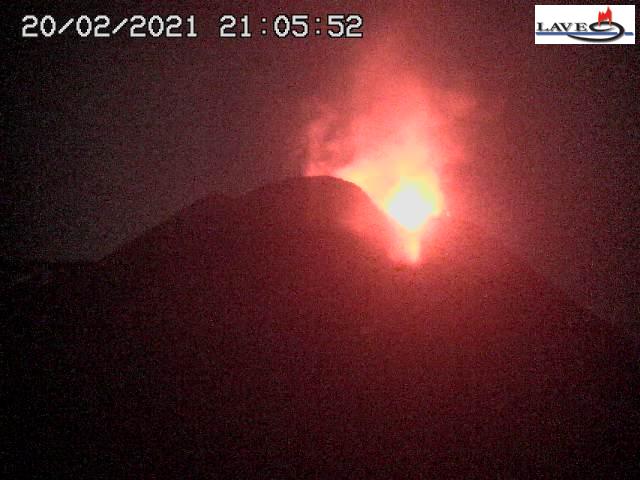
Strombolian explosion at Etna's New SE crater this evening (image: LAVE webcam)
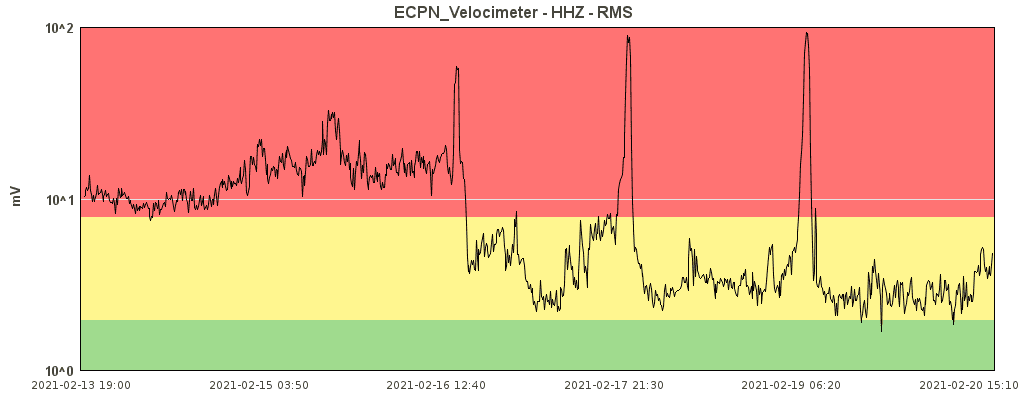
Current tremor signal (image: INGV Catania)
As the same time interval (approx. 35 hours) as between the past 3 lava fountaining episodes or paroxysms has now passed since the last eruption yesterday morning, it is now a guessing game whether Etna is now heading to produce the 4th in a new series.
It might well be: during the past hours, strombolian activity from the New SE crater and volcanic tremor have been showing an increasing trend, but it is still to early to be sure.
It might be worth following the activity during the next hours on the numerous
Etna volcano webcams...
Eruption ends
Update Fri 19 Feb 2021 10:19
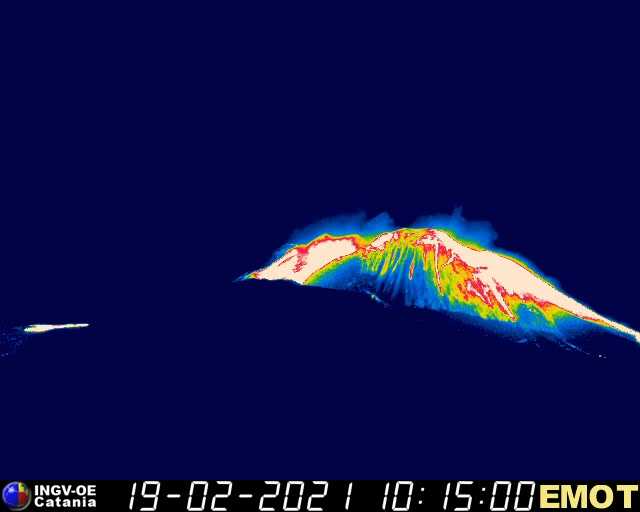
The New SE crater after the end of the lava fountains (image: thermal INGV webcam)
After little more than an hour with impressive fire fountains, the eruption quickly ceased and is now over. The lava flows to the south and east continue to descend, but may no longer be alimented.
The tremor signal started its rapid dive back to lower values as the supply of the just erupted batch of gas-rich fresh magma has been exhausted - until another one arrives from deeper reservoirs, maybe very soon...
Impressive eruption column with circular umbrella cloud towering above Sicily
Update Fri 19 Feb 2021 09:41

The eruption plume from this morning's paroxysm of Etna (image: Sara Raciti)

Lava fountains of 5-700 m from the New SE crater (image: INGV thermal webcam)
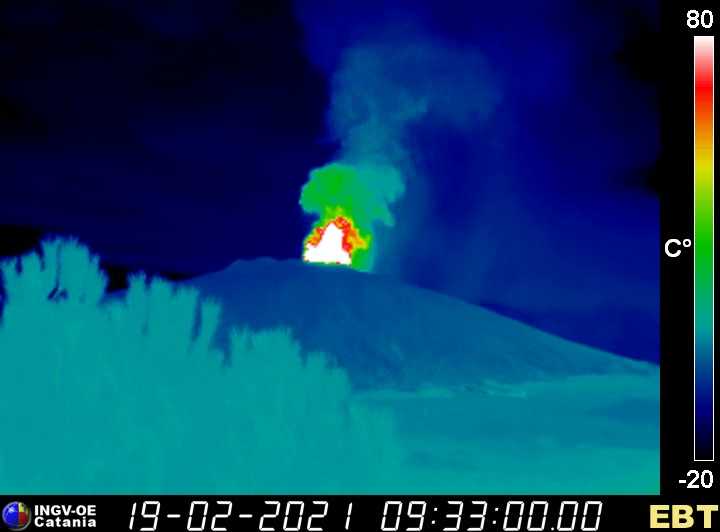
The eruption seen on the INGV thermal webcam in Linguaglosse (NE side)
About 45 minutes after the onset, the eruption is now at its peak, probably going to start to decrease soon.
An impressive eruption column is rising near vertically from the New SE crater, to heights of estimated 20,000 ft (6.3 km) according to the latest bulletin of the Volcanic Ash Advisory Center (VAAC) of Toulouse.
Lava fountains still increase
Update Fri 19 Feb 2021 09:25
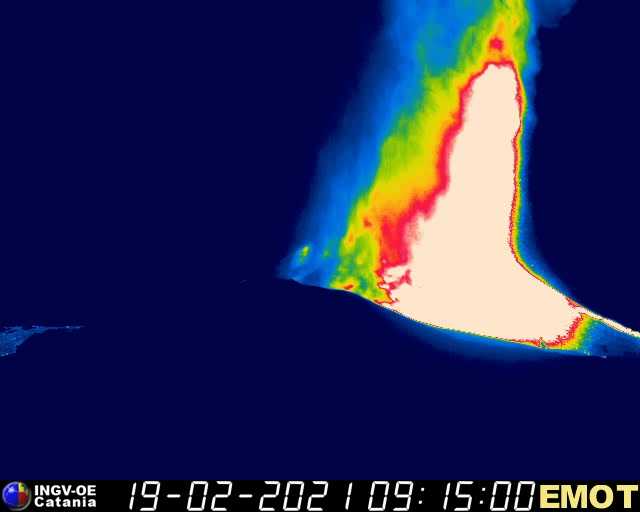
Lava fountains 500-700 m tall from the New SE crater (image: INGV webcam)
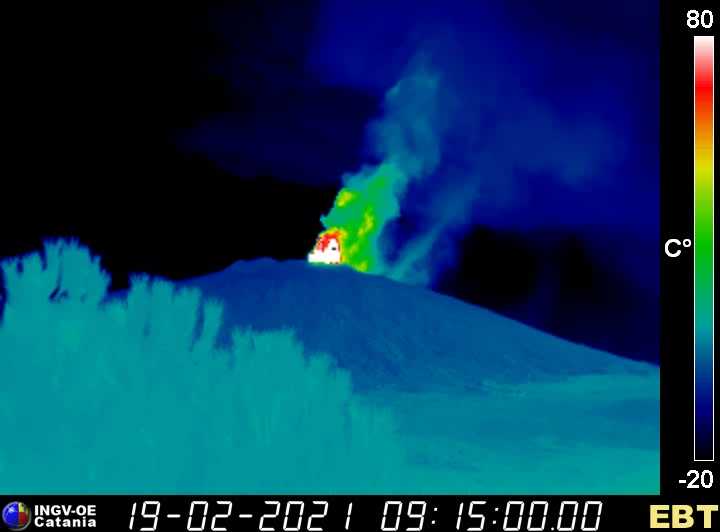
View from NE showing the mountain for scale (visual height approx. 2500 m) (image: INGV thermal webcam)
The still ongoing paroxysm appears to be even more intense than its two predecessors and still not The height of the lava fountains is likely more in the range of 700 m, something which will be determined later by the volcano observatory.
Eruption nears its peak, tall lava fountains reaching 500 m
Update Fri 19 Feb 2021 09:12
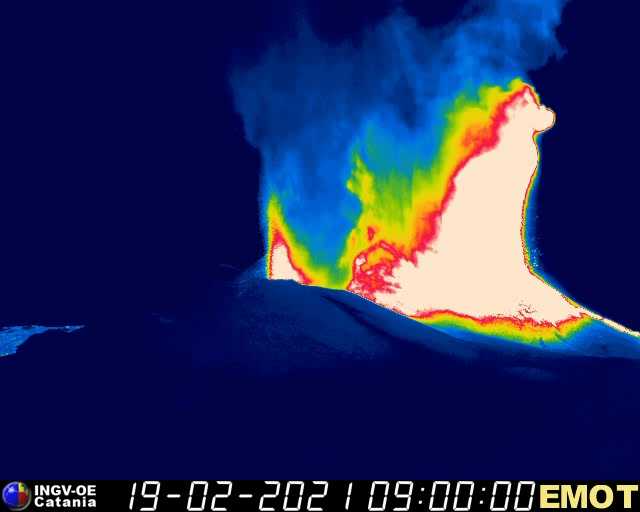
Lava fountains at the New SE crater during the peak of the ongoing paroxysm (INGV thermal webcam)

The eruption plume seen from the SW (RadioTouring webcam)
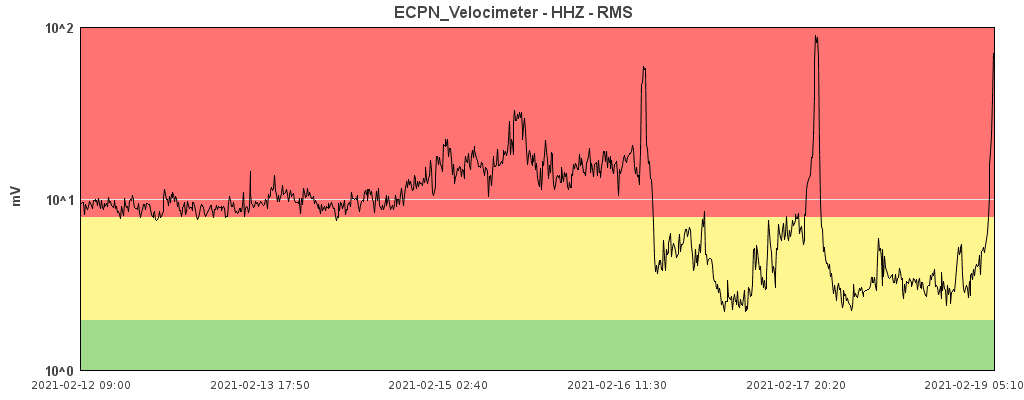
Current tremor signal (image: INGV Catania)
The paroxysm should be at its peak now. Tremor is extremely high, similar to yesterday's event, and tall lava fountains up to 500 m are rising from multiple vents of the New SE crater.
In fact, it seems that the vents are along a west-east fissure dissects the whole summit of the large cone.
A tall ash and steam plume is rising into the Sicilian sky and drifting to the south-southeast. Significant lapilli and ash fall can be expected on the southern flanks of Etna.
Lava fountains quickly increase to approx. 300 m height
Update Fri 19 Feb 2021 08:57

300 m lava fountain from Etna's New SE crater (image: INGV thermal webcam)
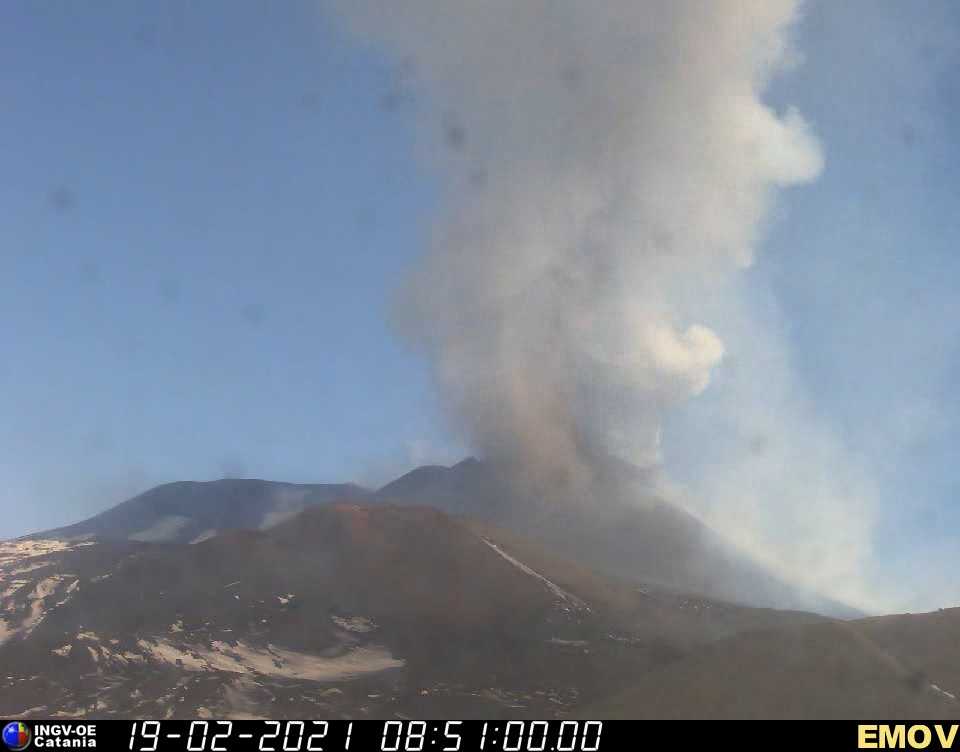
Corresponding visual view
The rate with which intensity increases is impressive. Within a few minutes since the onset, the lava fountains have already reached heights of approx. 300 m and still grow...
A tall ash and steam plume now rises several km above the crater.
Lava fountaining phase starting
Update Fri 19 Feb 2021 08:46
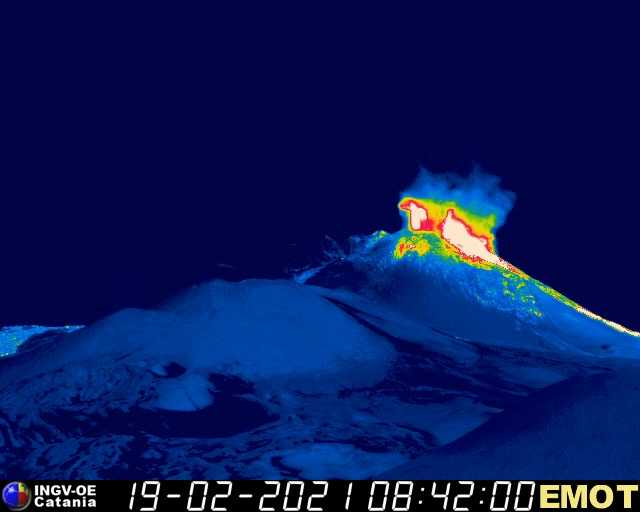
Beginning lava fountains at the New SE crater (image: INGV thermal webcam)
The new paroxysm is starting now, as lava fountains are beginning to rise from the summit and eastern vents of the New SE crater. Watch it live on the webcams at
http://webcams.volcanodiscovery.com/Etna!
Lava flow and strombolian activity increase, beginning of paroxysm seems immediate
Update Fri 19 Feb 2021 08:33
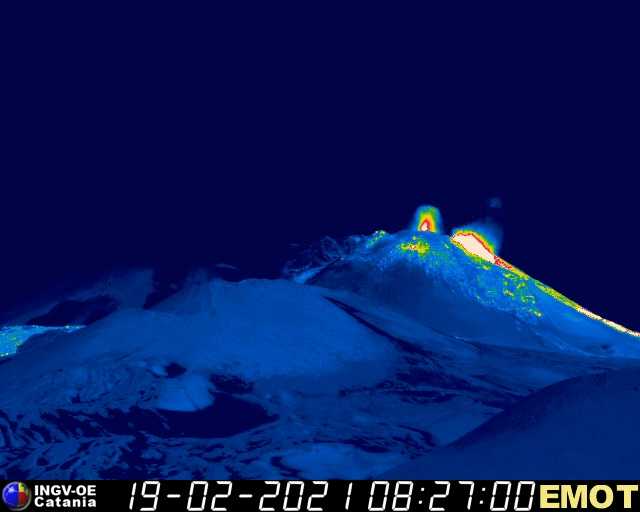
Thermal view from the south towards the New SE crater showing explosions at the summit vent and the lava flow (image: INGV thermal webcam)
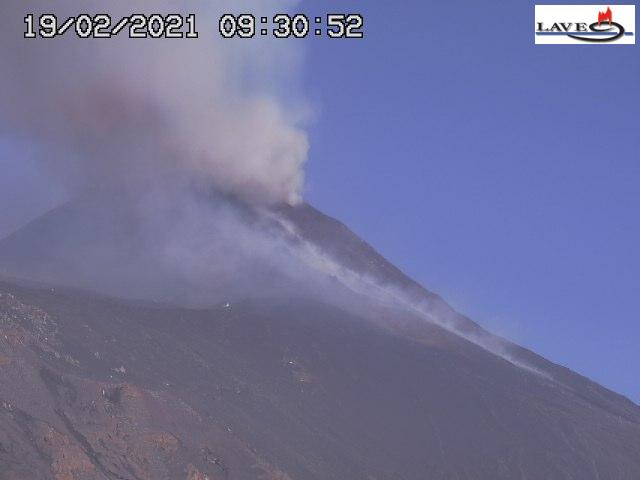
View fro the SE towards the New SE crater with the lava flow (LAVE webcam)
Accompanied by steeply rising tremor, activity increases now by the minute.
The lava flow that had begun half an hour ago or so now increases and starts covering yesterday's flow. At the summit vent, explosions or small fountains are now visible as well.
Tremor continues to rise, paroxysm very likely to occur in the next hour
Update Fri 19 Feb 2021 08:24
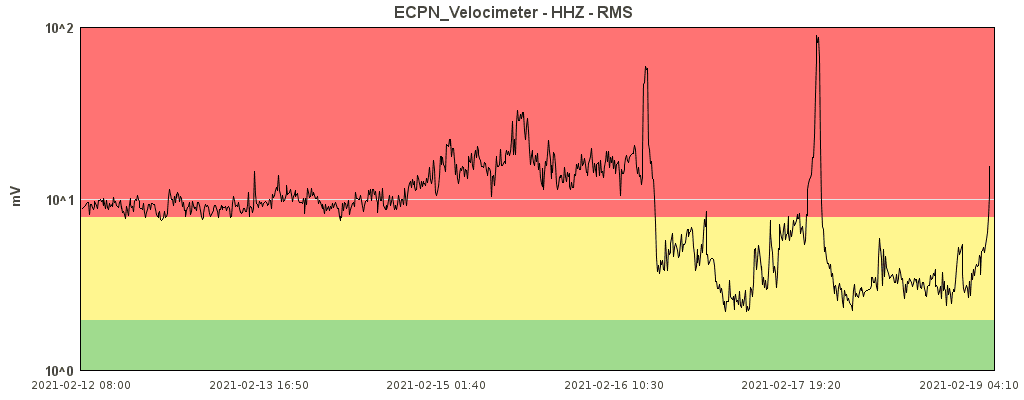
Rising tremor signal
As suspected, we probably see the beginning of another paroxysm. Tremor has started the typical steep rise. If true, lava fountains should be appearing very soon...
Lava low has started
Update Fri 19 Feb 2021 08:21

Thermal view of the New SE crater showing the lava flows starting to descend from the cone (image: INGV Catania thermal webcam)

Blurry image of the LAVE webcam showing the lava flow as well
Indications of a possible new paroxysm become stronger with the minute: lava flows have started to emerge from the summit vent of the New SE crater.
This is often a typical precursor to a lava fountaining episode and can be explained with new, gas-rich magma rising inside the conduits first pushing out the older degassed magma in the upper part of the conduits left from the previous episodes.
The situation is exciting!
Rising tremor - maybe new paroxysm underway?
Update Fri 19 Feb 2021 08:08

Diffuse ash is rising from Etna's SE crater (image: INGV webcam)
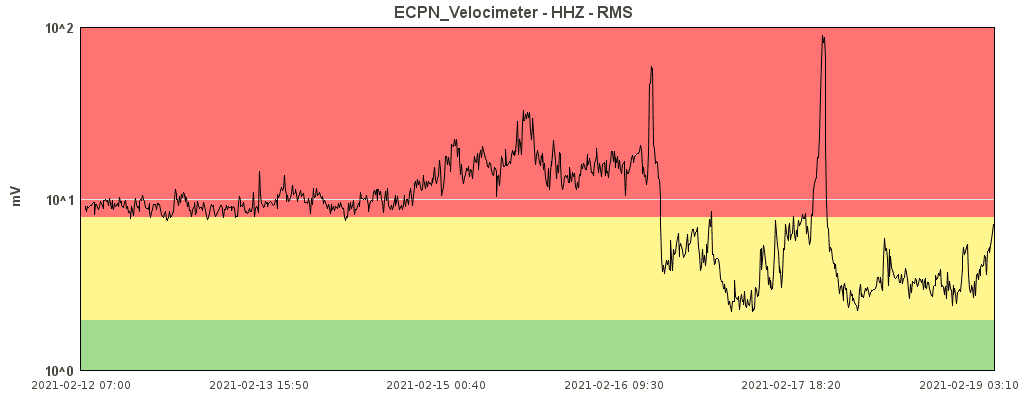
Current tremor signal (image: INGV Catania)

SO2 plume from yesterday's eruption (image: Royal Belgian Institute for Space Aeronom)
Approx. 30 hours have passed since the last lava fountain episode or paroxysm at Etna, which followed after 30 hours after the preceding one.
In the past, Etna has been known for producing series of paroxysms at similar, surprising regular intervals. Obviously, the question now is whether the next one will follow this pattern or not. At the time of writing this post, tremor seems to be rising indeed, first sign that activity increases.
At the surface, the New SE crater seems to have sporadic mild explosions, with a light ash plume rising.
Follow Etna live at:
webcams.volcanodiscovery.com/Etna
As to yesterday's paroxysm, the sudden large release of SO2 can still be traced on satellite data, the plume now having reached the northern coast of Africa.
Second spectacular eruption within 48 hours lights the night sky
Thu, 18 Feb 2021, 08:49 08:49 AM | BY: T
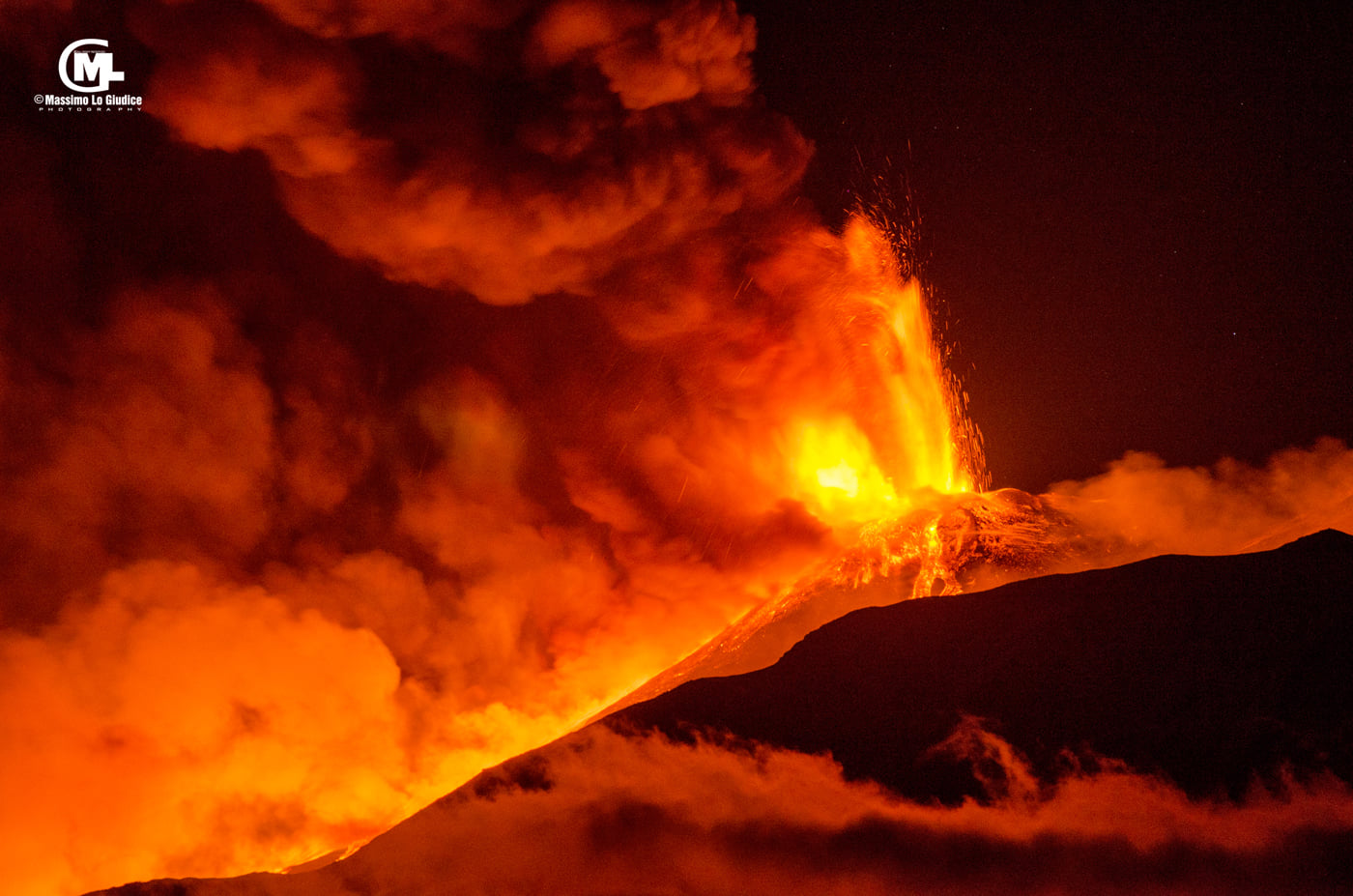
Lava fountains from Etna last night (image: Massimo Lo Giudice / facebook)
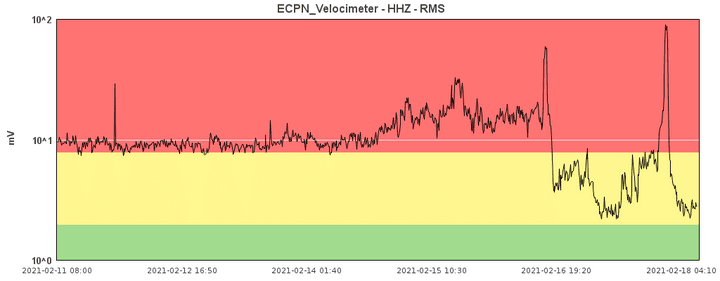
Tremor signal showing the two peaks of the recent paroxysms (image: INGV Catania)
Less than 30 hours after Tuesday's spectacular paroxysm (lava-fountaining episode), the volcano gave again an impressive display of fire, producing another similar and very powerful eruption last night.
After the end of the previous paroxysm on 16 Feb, the volcano's activity had actually dropped to the lowest levels in recent weeks, but that was about to change very quickly last evening.
Around 11 pm local time, the sop-far intermittent and mild strombolian explosions from the New SE crater began to increase significantly, both in size and frequency. At the same time, the monitoring network of INGV Catania detected a rapid rise of volcanic tremor signal, indication of magma moving underground towards the surface.
Less than two hours later, around 1 am this morning local time, the eruption reached its peak phase: for almost an hour, tall lava fountains shot into the night sky, reaching considerable heights of probably around 500 m or even more. Multiple large lava flows descended on several sides of the cone as well.
This time, lava flows not only descended eastwards into Valle del Bove, but also to the south covering similar areas as many lava flows that had inundated the the area previously known as Torre del Filosofo in the past few years.
The Volcanic Ash Advisory Center of Toulouse detected volcanic ash reaching an altitude of 10,000 m (30,000 ft).
This latest paroxysm is likely only one of others to follow, and indicates that Etna is once again in a phase of alternating between intermittent and rather mild summit activity and violent, but short-lived lava fountains. When the next one will occur is impossible to predict, - it could be tonight or tomorrow or in 4 or more weeks. Only Etna knows for sure.
In the meanwhile, you can check its activity on
various live webcams.
Massimo Lo Giudice (facebook)
Violent paroxysm with large lava fountain and lava flows
Update Tue 16 Feb 2021 21:15
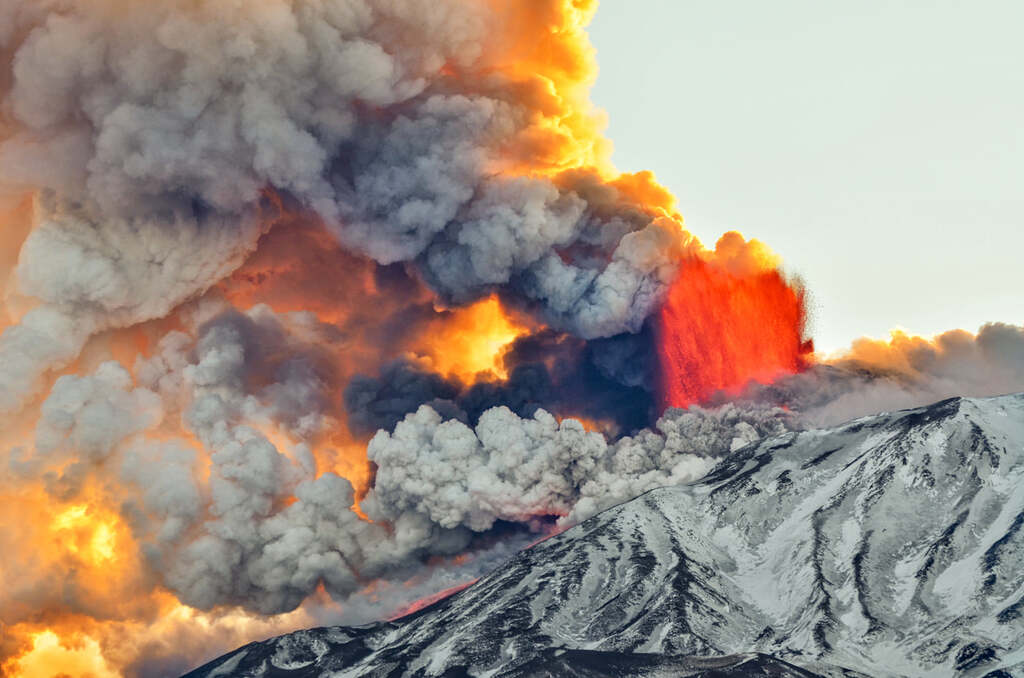
Lava fountain during Etna's paroxysm this afternoon (image: Massimo Lo Giudice / facebook)
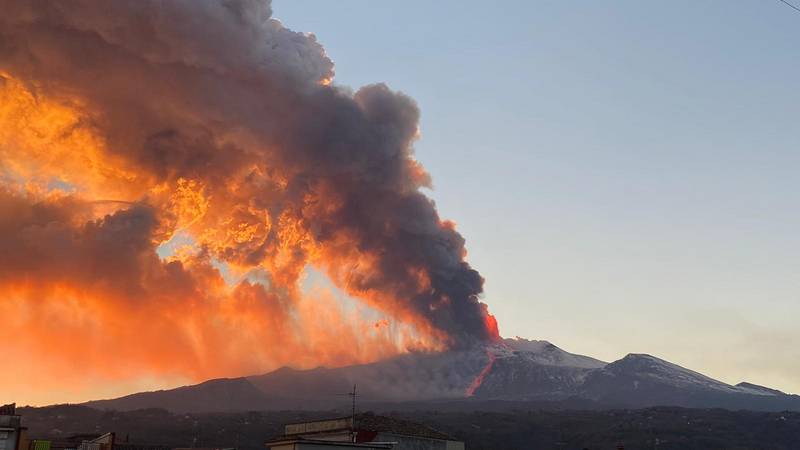
The lava fountain and ash plume in the beginning of the eruption (image: Sara Raciti)

The lava flow into Valle del Bove (image: Sara Raciti)
This afternoon, Etna produced a very spectacular lava-fountaining eruptive episode, known as paroxysm.
Starting from around 5 p.m. local time in the afternoon, the strombolian activity, which had been going on for the past weeks from the New SE crater intensified significantly. Shortly after, a lava overflow was observed from the eastern side of the South East crater. At 16:05 UTC (5:05 p.m. local time), a part of the eastern flank of the cone collapsed into a pyroclastic flow that traveled down the western wall of the Valle del Bove depression.
The flow, as hot material was sliding over snow, produced an ash and steam cloud that quickly dispersed from high altitude winds to the south.
5 minutes later, the explosive activity at the SE crater increased further into lava fountains several hundred meters high, which produced a tall ash plume that rose to up to approx. 10 km elevation (30,000 ft) above sea level, i.e. 7 km above the craters.
The eruption was accompanied, as usual, by a sharp increase in tremor reflecting the sudden high discharge rate of magma being pushed to the surface by expanding gasses in a jet similar to opening a pressurized champagne bottle.
A significant lava flow with two main branches to the east and northeast was quickly flowing from the crater. The larger one to the east quickly reached the bottom of the Valle del Bove approx. 1000 m below.
After about one hour, from 6 p.m., the activity quickly decreased and almost ceased.
By now, it has returned to similar style as it had been during the past days and weeks: there is mild to moderate, but intermittent strombolian activity from at least 3 summit vents, Voragine, Bocca Nuova and the New South-East crater.
Sources:
-
INGVulcani (facebook)
-
Massimo Lo Giudice (facebook)
First visit to our site? If you havn't done it yet,
download the Volcanoes & Earthquakes app to get one of the fastest volcano news online:
Android |
IOS














































